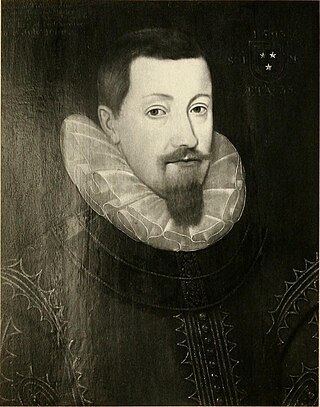Related Research Articles
William Schaw was Master of Works to James VI of Scotland for building castles and palaces, and is claimed to have been an important figure in the development of Freemasonry in Scotland.
William Graham, 2nd Earl of Montrose was a Scottish nobleman and statesman, who successfully steered a moderate course through the treacherous waters of mid-16th century Scottish politics.

Andrew Mansioun, or Mentioun or Manschone or Manson, was a French artist who worked at the court of James V, King of Scots. He was the master carpenter of the Scottish artillery for Mary, Queen of Scots and James VI of Scotland.

The King's Wark in Leith was a building on the Shore of Leith, at the mouth of the Water of Leith into the Firth of Forth. The King's Wark was the Scottish royal arsenal where cannon used on royal ships were kept and maintained, and where supplies shipped to Leith for the royal household were stored. To the north east of the King's Wark the Shore was extended into the sea by a pier known as the "Bulwark". To the west was the Broad Wynd, and on the south, there was a walled yard. An inn on the site was documented in 1623. The site on the Shore includes a public house and restaurant called "The King's Wark" on the corner of the Shore and Bernard Street.

John Murray, 1st Earl of Tullibardine was a Scottish courtier and leader of the Clan Murray.
Nicholas (Nicol) Uddert or Udward or Udwart or Anglicised as Nicol Edward was a 16th century Scottish merchant who served as Provost of Edinburgh in 1592/93.

On 17 May 1590, Anne of Denmark was crowned Queen of Scotland. There was also a ceremony of joyous entry into Edinburgh on 19 May, an opportunity for spectacle and theatre and allegorical tableaux promoting civic and national identities, similar in many respects to those performed in many other European towns. Celebrations for the arrival of Anne of Denmark in Scotland had been planned and prepared for September 1589, when it was expected she would sail from Denmark with the admirals Peder Munk and Henrik Gyldenstierne. She was delayed by accidents and poor weather and James VI of Scotland joined her in Norway in November. They returned to Scotland in May 1590.
Sir James Sandilands was a courtier to King James VI and I and captain of Blackness Castle
William Murray of Tullibardine was a Scottish courtier and leader of the Clan Murray.

Jacques de Bousie was a Flemish confectioner known as a "sugarman" working in Edinburgh, Scotland, employed by James VI and Anne of Denmark.
Robert Jameson was a Scottish shipowner from Ayr.
William Fairlie or Fairley was an Edinburgh merchant and burgess.
Robert Abercromby or Abircrumby was a Scottish leatherworker serving the Scottish monarchy in the 16th century.
Jerome Bowie was a servant of James VI of Scotland as a sommelier and Master of the Wine Cellar, in charge of the purchase and serving of wine.
Alexander Hay of Easter Kennet was a Scottish lawyer and politician.
Thomas Annand was a Scottish goldsmith based in Edinburgh.

William Stewart of Grandtully (1567–1646) was a Scottish landowner and courtier.

Records survive of the expenses made to feed the Scottish royal household in the sixteenth century, and the remains of royal kitchens can be seen in the ruins of palaces and castles. Archaeologists can recover evidence of diet from deposits including waste from meals and food preparation.
John Clavie or Clavee was a Scottish apothecary who worked for James VI and I and the royal family.
Hans Poppilman was a Danish cook who served Anne of Denmark in Scotland and England.
References
- ↑ Marguerite Wood, "Domestic Affairs of the Burgh, 1554-1589", Book of the Old Edinburgh Club, 15 (Edinburgh, 1927), p. 30.
- ↑ Charles Thorpe McInnes, Accounts of the Treasurer, vol. 13 (Edinburgh, 1978), p. 284.
- ↑ David Masson, Register of the Privy Council of Scotland, vol. 3 (Edinburgh, 1880), pp. 452-3: National Records of Scotland, E34/35.
- ↑ Miles Kerr-Peterson & Michael Pearce, 'James VI's English Subsidy and Danish Dowry Accounts, 1588–1596', Scottish History Society Miscellany XVI (Woodbridge, 2020), p. 75.
- ↑ Michelle Beer, Queenship at the Renaissance Courts of Britain (Woodbridge, 2018), p. 78: James Balfour Paul, Accounts of the Lord High Treasurer of Scotland, vol. 2 (Edinburgh, 1900), pp. lxxii, lxxviii, 386: Sarah Carpenter, '"To thexaltacyon of noblesse": A Herald’s Account of the Marriage of Margaret Tudor to James IV', Medieval English Theatre, 29 (2007): Thomas Hearne, Collectanea de Rebus Anglicanis, vol. 4 (London, 1809), p. 298.
- ↑ George Powell McNeill, Exchequer Rolls of Scotland, 1589-1594, vol. 22 (Edinburgh, 1903), p. 33.